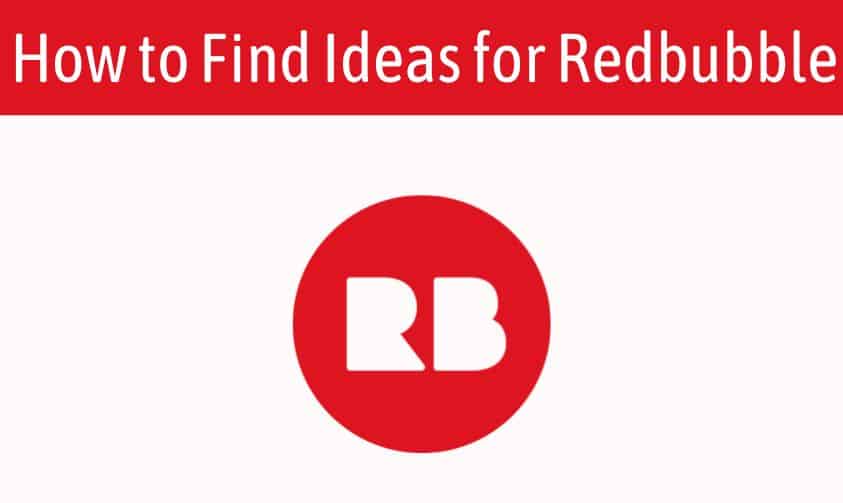Unleashing your creativity to find unique and compelling design ideas is crucial for success in the Redbubble marketplace.
In this guide, we’ll dive straight into effective methods to generate ideas that resonate with your audience, leading to enhanced engagement and increased sales.
Let’s kickstart your creative journey!

How to Find Ideas for Redbubble
Step 1: Understand Your Audience
First things first, you need to understand who your potential customers are. Who would be interested in your designs? What are their hobbies, interests, and the things they are passionate about? The more you understand about your audience, the better you’ll be at creating designs that appeal to them.
Step 2: Research Popular Trends
One effective way of finding ideas for your Redbubble designs is to keep an eye on popular culture. Movies, music, TV shows, memes, and current events can all provide inspiration. However, make sure to respect copyright laws. You can also check Redbubble’s trend report and Google Trends to find out what people are currently interested in.
Step 3: Find Inspiration on Social Media
Social media platforms like Instagram, Pinterest, and TikTok are teeming with potential design ideas. Follow influencers, artists, and trendsetters in your target niche and keep track of the themes and styles that gain the most traction. You can also use hashtags related to your niche to explore trending posts.
Step 4: Understand SEO
SEO is a key component of your success on Redbubble. Use keywords in your product titles, descriptions, and tags that your target audience would use to find products like yours. Tools like Google Keyword Planner or Answer the Public can help you find relevant keywords.
Step 5: Leverage Communities and Forums
Join communities on platforms like Reddit or Quora where people discuss their interests. This can give you insights into what people in your target audience are talking about, asking questions about, or showing interest in.
Step 6: Experiment and Test
The process of finding design ideas also involves a good deal of trial and error. Don’t be afraid to try out different ideas and see how they perform. Use the analytics provided by Redbubble to understand which of your designs are popular and why.
Step 7: Consistent Brainstorming
Finding design ideas is not a one-time task. You need to regularly brainstorm and come up with new ideas to keep your store fresh and interesting. Create a schedule and dedicate time for brainstorming sessions.
Step 8: Utilize Design Tools
If you’re struggling to visualize your ideas, use design tools like Canva or Adobe Illustrator to experiment. This can also help you see what your design might look like on a product.
Step 9: Keep an Idea Journal
Ideas can strike at any time, so keep an idea journal. Write down anything that sparks inspiration, no matter how small or seemingly insignificant. Over time, you’ll have a reservoir of ideas to tap into.
Step 10: Don’t Forget About Seasons and Holidays
Seasonal designs, like Christmas, Halloween, or Valentine’s Day, always tend to sell well. Plan ahead and have designs ready for these big selling periods.
Now let’s look at some tools that can help you in this process.
Here are some tools and resources that can be leveraged to generate ideas for your Redbubble designs:
1. Google Trends: This is an invaluable tool for identifying what’s currently trending across the globe. You can drill down into categories, geographic regions, and specific timeframes.
2. Keyword Tools: Tools like Google’s Keyword Planner, SEMRush, and Answer the Public can provide you with insight into what people are searching for online, which can guide your design themes and descriptions.
3. Pinterest: Pinterest is a treasure trove of inspiration. Users curate boards based on their interests, making it easy to see what’s trending in any given area.
4. Instagram and TikTok: By following influencers, artists, and other creatives, you can see what’s currently popular and potentially leverage these trends in your designs.
5. Reddit and Quora: These platforms are home to countless communities (subreddits and threads) where people discuss their interests, problems, and questions. These can provide insights into what’s currently engaging your potential customers.
6. Social Listening Tools: Tools like Brand24, Hootsuite, and BuzzSumo can help you monitor specific keywords, trends, and topics across various social media platforms.
7. Design Tools: Tools like Canva, Adobe Spark, and InVision can help you visualize your ideas and see what they might look like as a final product.
8. Feedly: This tool allows you to curate and follow content from various blogs and websites, giving you a steady flow of potential inspiration.
9. Marketplaces: Look at other popular designs on Redbubble, Etsy, and similar marketplaces for inspiration. This can help you gauge what consumers are interested in.
10. Color Palette Tools: Tools like Coolors or Adobe Color can help you explore interesting color combinations.
Don’ts When Seeking Inspiration and Ideas
1. Don’t Copy Other Artists: Drawing inspiration from others is okay, but outright copying is not. It’s unethical, could harm your reputation, and may result in legal issues. Always respect other artists’ work.
2. Don’t Ignore Your Audience: While it’s important to create designs you love, remember to cater to the interests and tastes of your target audience. They’re the ones purchasing your products.
3. Don’t Neglect SEO: Optimize your product titles, descriptions, and tags with relevant keywords. Ignoring SEO can make it much harder for potential customers to find your designs.
4. Don’t Be Discouraged by Failure: Not every idea will be a winner, and that’s okay. Don’t let unsuccessful designs discourage you. Learn from them and keep trying.
5. Don’t Rush the Process: Finding inspiration and creating a design takes time. Don’t rush the process in an attempt to pump out as many designs as possible. Quality trumps quantity every time.
That’s it.
Remember, finding the perfect design idea takes time, research, and a bit of creativity. Stay patient, keep an open mind, and your Redbubble store will be flourishing with unique and trendy designs in no time!